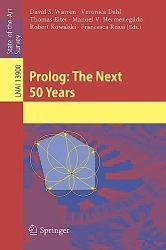Prolog: The Next 50 Years
- Добавил: literator
- Дата: 18-06-2023, 15:55
- Комментариев: 0
 Название: Prolog: The Next 50 Years
Название: Prolog: The Next 50 YearsАвтор: David S. Warren, Veronica Dahl, Thomas Eiter
Издательство: Springer
Серия: Lecture Notes in Computer Science Book
Год: 2023
Страниц: 399
Язык: английский
Формат: pdf (true)
Размер: 25.1 MB
This volume was motivated by the Year of Prolog initiative, launched to celebrate the 50th anniversary of the emergence of Prolog through the work of Alain Colmerauer’s team in Marseille. The volume editors, authors, and scientific advisors and reviewers have been the leading researchers and programmers in this field over decades, and the book represents an excellent overview of the field, its successes, and its future.
Prolog is a logical language for making true statements about a world, whose statements can be interpreted as a program and thus evaluated to conclude an answer to a question. Functional programs are understood as defining functions whereas Prolog programs are generally understood as defining relations.
Dynamic Logic Programming (DLP) is an extension to logic programming designed to support the representation of knowledge about dynamic worlds. It combines the strengths of safe, stratified, side-effect-free logic programming in defining relations with the power of simultaneous transition rules for defining dynamic operations. Because relation definitions in DLP are safe and stratified and side-effect-free, dynamic logic programs are simpler than general Prolog programs and they allow for efficient implementation. At the same time, defining operations using simultaneous transition rules adds expressive power without compromising the conceptual simplicity of logic programming. DLP is the basis for the logic programming language Epilog (aka Dynamic Prolog).
After a first chapter that gently introduces the Prolog programming language using examples, the next 7 papers discuss general views of the language, possible extensions for the future, and how Prolog can generally be used to solve problems; the next 5 papers explore ideas and experiences of teaching Prolog programming and then 2 papers discuss technology that has been developed for help in that teaching; the next 3 papers describe new languages based on Prolog which show future directions for logic programming; the next 5 chapters explain the applications that were the finalists for the 2022 Alain Colmerauer Prize; and the final 8 papers describe applications developed using the Prolog language, demonstrating the language’s range.
Our analysis centers on the main driving force in the evolution of programming languages: automation of coding tasks, a recurring promise of declarative languages, instrumental for developing software artifacts competitively. In this context we will focus on taking advantage of the close correspondence between logic-based language constructs and their natural language equivalents, the adoption of language constructs enhancing the expressiveness and learnability of logic-based programming languages and their synergistic uses in interacting declaratively with deep learning frameworks.
Contents:
Скачать Prolog: The Next 50 Years
Внимание
Уважаемый посетитель, Вы зашли на сайт как незарегистрированный пользователь.
Мы рекомендуем Вам зарегистрироваться либо войти на сайт под своим именем.
Уважаемый посетитель, Вы зашли на сайт как незарегистрированный пользователь.
Мы рекомендуем Вам зарегистрироваться либо войти на сайт под своим именем.
Информация
Посетители, находящиеся в группе Гости, не могут оставлять комментарии к данной публикации.
Посетители, находящиеся в группе Гости, не могут оставлять комментарии к данной публикации.

